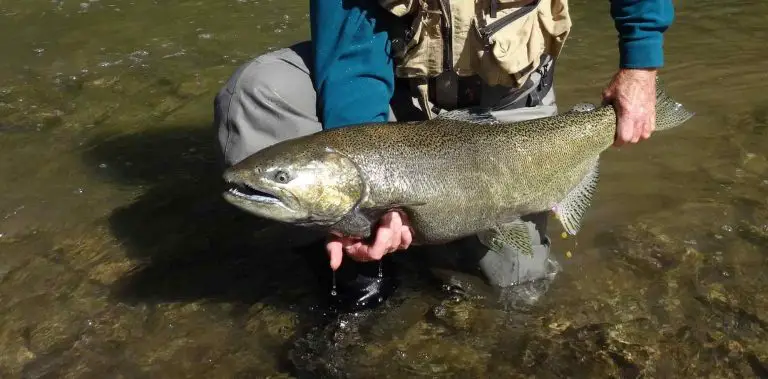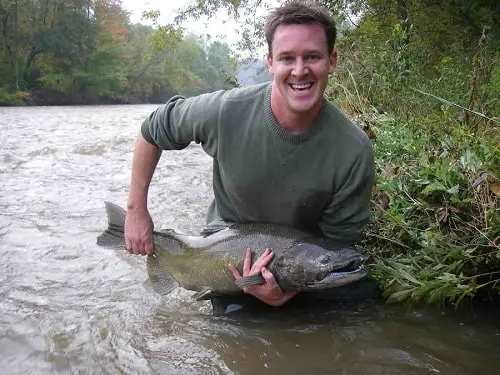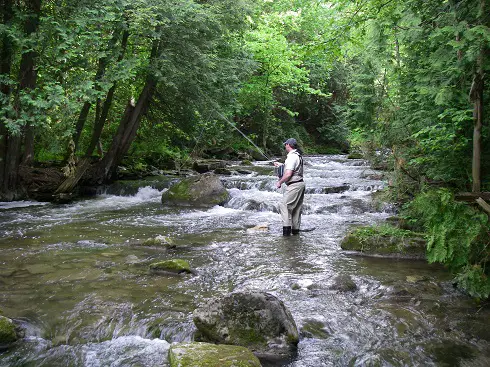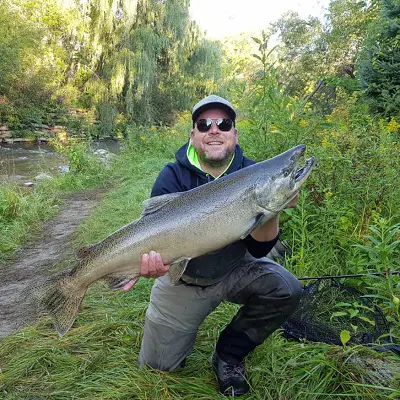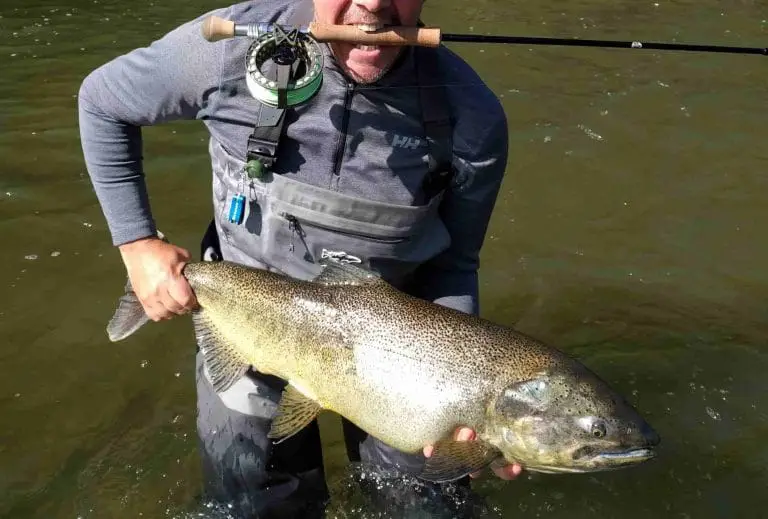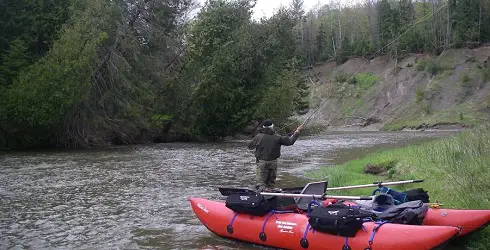Salmon Fishing With Beads
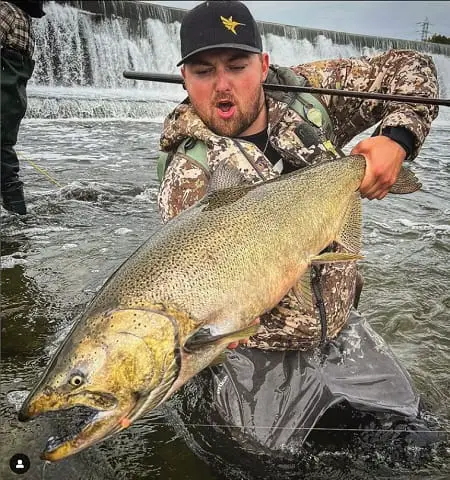
Salmon fishing with beads is growing in popularity, but for well over a decade and a half, I’ve considered beads as one of my top three most effective baits for salmon in rivers.
These beads are a perfect imitation of single, freely drifting salmon or trout egg, which are hard for most salmon to pass up.
Bead fishing for salmon is a skillful technique that triggers salmon to bite, since the bead is mimicking their favored meal, fish eggs. Understanding the nuances of bead choice, such as types, sizes, colors, setup, and accompanying hooks, can drastically enhance your salmon catching capabilities.
My introduction to the effectiveness of beads in salmon fishing came from customers at my fishing store around 2006. Over time, bead use has become so successful that most seasoned anglers and salmon guides, myself included, rely on it.
In this article, I’ll tell you the most effective beads based on 15 years of experimenting with beads in all types of conditions. Also, I’ll discuss my most effective methods of salmon fishing with beads, I’ll show you my bead rig, share my tips for switching beads quickly, as well as other insights to improve your salmon fishing experience.
Selecting The Right Beads For Salmon
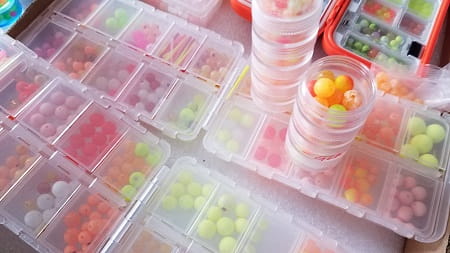
Regardless of whether they are marketed as trout, steelhead, or salmon beads, their function remains the same: imitating fish eggs to catch salmon.
Beads can be made from various materials, including glass, plastic, and rubber, each available in a multitude of sizes and colors. Every type has its benefits and drawbacks, which I’ll delve into below.
Understanding the available bead types and their performance under different fishing conditions is key.
Perks of Utilizing Plastic Beads for Salmon Fishing
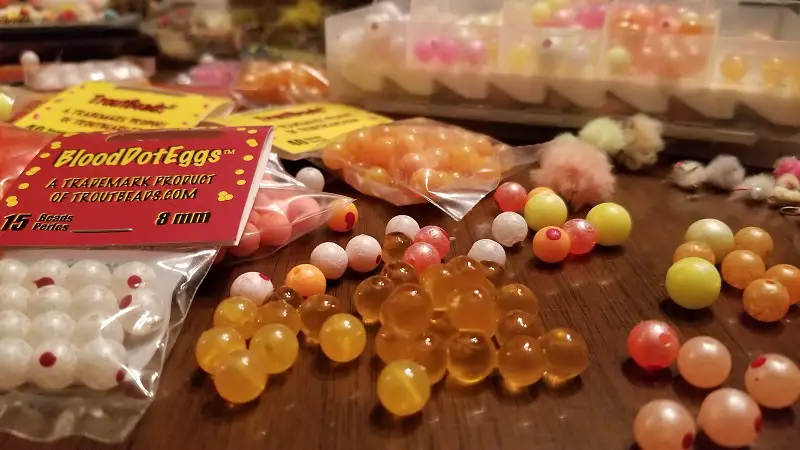
Plastic beads, such as those from the renowned TroutBeads, have become a top choice for salmon fishing due to their accessibility and cost-effectiveness when compared to their glass counterparts.
These solid plastic beads have a slower sinking rate compared to dense glass beads, making them a great choice for shallower rivers with depths less than 8 feet since they don’t need to plummet as deeply.
Regardless, I generally prefer the use of plastic beads because, if your fishing line and weights are appropriately adjusted, the floating effect of the lighter beads mimics the natural drift of real salmon eggs, which can tempt more fish to bite.
However, there’s a school of anglers who swear by the efficacy of glass beads, a topic we’ll delve into next.
Plastic beads are available in a broad spectrum of colors and sizes, providing flexibility in diverse fishing scenarios. They prove particularly potent in rivers with sandy bases or when angling for salmon in less deep waters.
Glass Beads: A Game-changer for Salmon Fishing
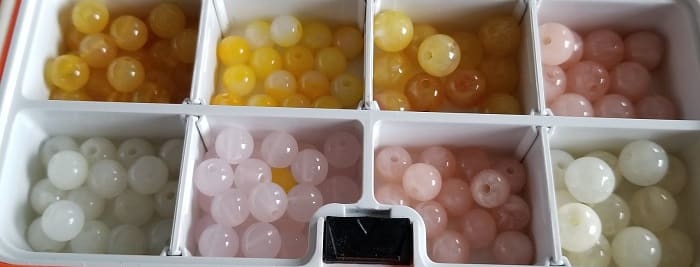
There’s a faction of anglers who vouch for the superior performance of glass beads in luring salmon, and for most, their bet is spot on.
The primary asset of glass beads is their heaviness, allowing them to descend rapidly and stay in the biting zone for a more extended period. This feature indeed serves many anglers well.
However, it’s crucial to point out that the success of glass beads might also be tied to aspects like the angler’s bait presentation and the configuration of their fishing line.
From my extensive observations of numerous anglers, I’m convinced that most don’t allow their lines to reach deep enough, often due to inadequate line setup and poor detection of the river bed to optimize their bait presentation.
Since glass beads have a weighty nature, they can reach deeper depths, which is why I think they hook more salmon than their identical-looking plastic counterparts.
If you observe that glass beads fetch better results, consider refining your bait presentation technique, or simply add more weights and extend your line to attain more depth with lighter baits.
Soft Beads for Salmon Fishing
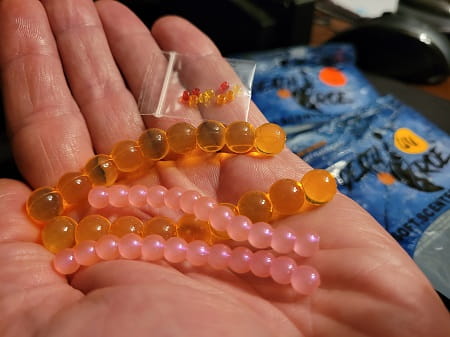
Soft beads made of flexible plastic or rubber can also prove successful in salmon fishing.
These soft beads are usually attached directly to the hook or strung onto the line, and they facilitate easy removal and replacement compared to hard beads.
While some anglers think that salmon tend to grip soft beads longer since they resemble the softness of real salmon eggs, I’m not entirely convinced. Nevertheless, soft beads are worth trying out, particularly in situations where hard beads might not be very effective.
If I were to estimate, I’d say hard beads are employed 90% more frequently than soft ones.
Choosing the Right Size of Beads
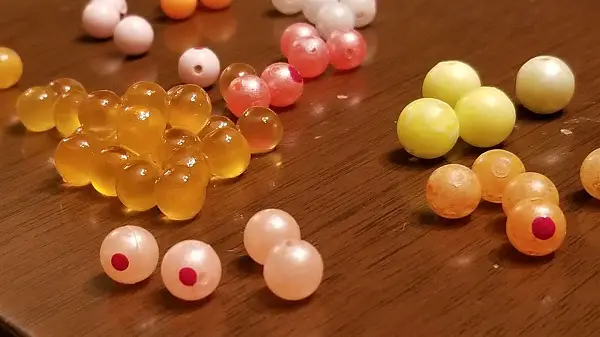
There are four sizes of beads ideal for different water conditions. A 6mm bead mirrors the egg size of brown trout or rainbow trout, while an 8mm bead simulates the typical salmon egg size.
In most rivers where salmon are abundant, 8mm is the most common bead size.
Larger beads of size 10mm and 12 mm are more noticeable in swift currents and therefore more appealing to salmon.
In clear water, I usually opt for smaller 8mm beads. But for murkier waters, I might use a 10mm or even a 12mm bead. From my experience, 8mm beads perform well in both clear and slightly clouded water.
The Perfect Bead Colors for Salmon
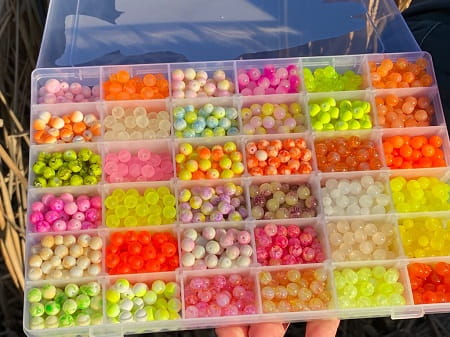
The best bead colors for salmon fishing often come in shades of yellow, orange, and pink. Chartreuse is often hot, but it can also be ineffective. It often depends on water clarity and light conditions.
As an example, many days Chartrues beads are hot at dawn and dusk, but in clear water mid-day with bright sun, peaches, pinks, and oranges are often best.
Different brands offer a variety of color choices, including mottled beads and blood dot beads, which are colored beads marked with a red dot.
A color’s effectiveness can vary, so don’t hesitate to experiment to see which hues yield the best results under various fishing conditions. I generally have 6 to 1o colors and all 4 sizes of beads on hand.
Years of testing various colors and sizes under numerous conditions and seasons have provided valuable insights. Follow my bead charts to find the best colors for specific conditions.
Choosing the Right Hooks for Bead Fishing
Selecting an appropriate hook is critical when fishing with beads. Hooks like the Raven Specimen and Gamakatsu Octopus hooks have proven their worth.
The size of the hook should align with the bead size, water depth, current speed, and river clarity.
Generally, hooks ranging from size 4 to size 8 are most suitable for catching salmon in all types of water.
While some anglers may opt for smaller hooks of size 10 or 12, I wouldn’t recommend using anything smaller than size 10 due to their lower hooking and holding power. Plus these small hooks have a tendency to bend when fighting large salmon.
Conversely, hooks larger than size 4 can weigh down the bead, impairing its natural drift, and potentially preventing salmon from biting.
In water conditions ranging from clear to slightly murky, my go-to size is size 6 or 8. In dirty water, my go-to size is 6 but will also use a size 4.
Fishing For Salmon With Beads in Rivers
When salmon fishing with beads, I only use beads in rivers with current. Given that beads are artificial, lacking scent, and have a hard texture, in a river, as the beads drift past the salmon, they have limited time to inspect the bait, which increases your chances.
They either grab it or they don’t as it drifts by and the faster the current, the better. I approach many of my preferred artificial baits in the same way.
Methods of Fishing for Salmon With Beads
There are several methods you can use to fish for salmon with beads, including float fishing, drift fishing, and bottom bouncing. Heck, I’ll even use beads when I’m fly fishing!
Float fishing for salmon with beads, a technique where the beads are suspended just above the riverbed under a float, is my favorite method for bead fishing in most river that are 4 to 10 feet deep. This strategy keeps your bead in a salmon’s strike zone longer and decreases the chances of snagging.
Drift fishing for salmon with beads, where the bait is cast upstream and allowed to drift downstream naturally with the current without the aid of a float or bobber. This technique can be particularly successful in faster water currents. However, it does require some skill to prevent the bead from getting stuck at the bottom or drifting too fast.
Bottom bouncing for salmon with beads, where the bait is allowed to bounce off the river bed, can be another effective method for fishing in certain conditions, such as in deeper or faster waters. This method requires a heavier weight to keep the bead bouncing along the bottom and can be challenging to master but very rewarding when done correctly.
When fly fishing, I usually use beads in conjunction with egg-sucking leech patterns or similar flies. The bead attracts the fish’s attention, and the hook on the fly secures the catch.
Rigging Your Beads
When salmon fishing with beads, the way you rig your beads plays a crucial role in your success. You need to have your beads drifting naturally in the current to entice the salmon. Here’s how you can rig your beads for success:
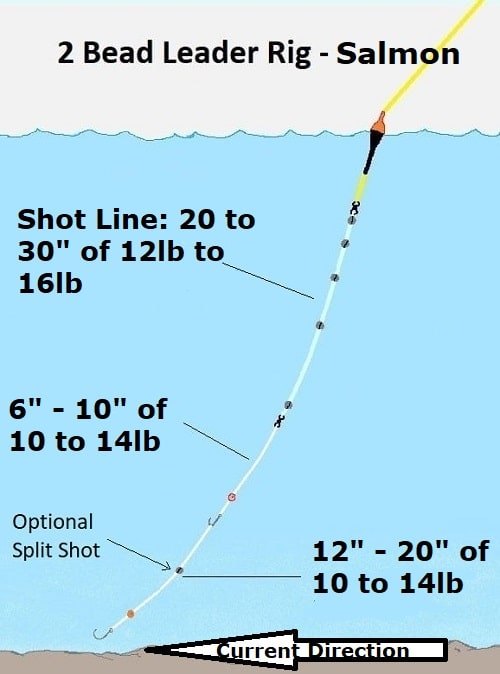
- Thread the line through the bead hole and tie the line to your hook.
- Move the bead about 1.5″ to 2 inches up the line away from the hook.
- Use a toothpick or bead peg to fix the bead in place on the line. Push the toothpick into the bead hole and break off the excess toothpick sticking out from the bead.
- Check the bead to ensure it’s secure but not too tight on the line. The bead should have a little play, which allows it to rotate, adding to the illusion of a real egg.
Remember, the key when salmon fishing with beads is to ensure that the bead appears as natural as possible in the water.
Securing Beads to the Fishing Line
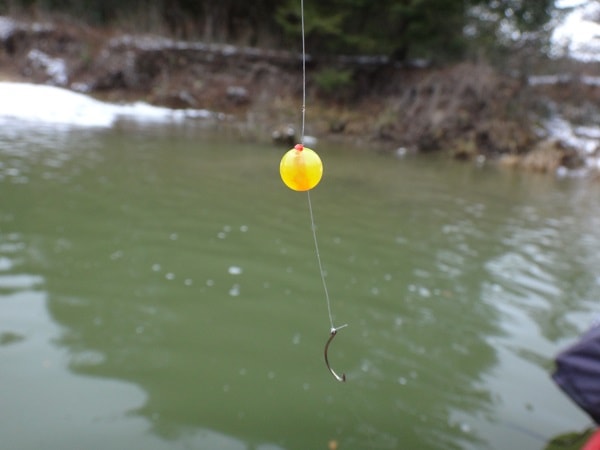
There are various strategies for securing beads to the line, which include rubber bead pegs (my personal favorite), broken or cut-to-length toothpicks, bobber stops, specialized loop knots, and even petite rubber bands.
Rubber bead pegs, like those from TroutBead, are favored for their ability to allow the bead to glide when a fish takes the bait. Many fishing guides, including myself, believe this results in more effective hook sets.
It’s important to select a method that firmly fastens the bead to prevent it from unintentionally slipping.
Organizing and Storing Your Beads
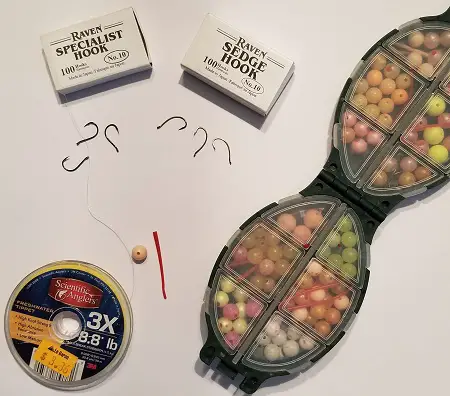
Managing a vast array of beads can be a complex task, but organizing them efficiently assures a smooth experience while fishing.
Storing beads in boxes with separate covered compartments helps avoid unintended spillages and facilitates easy access to beads of various sizes and colors.
Having a smaller day-box with a selection of beads is safer and easier to carry.
Pro-tip from a guide: Many of my clients and friends found this useful. Preparing bead rigs in advance saves precious fishing time and allows for swift transitions between different bead configurations. With a pre-rig, I can swap a bead in under a minute.
This strategy has proven to be a game-changer in freezing conditions, as rigging a bead from scratch can take some anglers over 5 minutes and some frozen fingers.
The following section is more critical than most anglers realize, so don’t overlook it.
Mastering the Hook Set
When a salmon encounters a real salmon egg, it’s soft, juicy, and flavorful, and they’ll gulp it down. However, beads are hard and tasteless. This hardness means that the salmon are likely to eject them quickly, often in less than two seconds!
Therefore, learning to set the hook faster can considerably boost your catch rates. This means the moment your float shifts, bobs, twitches, and set the hook. I frequently set the hook even before the float drops.
The Snagging Debate: Do Beads Snag Fish?
I’ve encountered anglers who abandoned salmon fishing with beads because they believed they snagged too many salmon in the belly, fins, or tail. They assumed that beads snag fish! But is this correct?
My response is a mix of yes and no.
Yes, beads tend to snag more fish than other baits, but the blame lies with the anglers doing something incorrect.
Unintentional snagging often stems from delayed hook sets. Slow reflexes can result in the fish spitting out the bait before the hook is correctly set inthe mouth.
Since the bead is ejected so swiftly, by the time the angler reacts to the float going down, the bead is out of the mouth and alongside the fish when the hook is set. This delayed hook set results in snagging the salmon in the body.
By setting the hook fast, as I do and teach my clients, you can reduce accidental snags and enhance your likelihood of landing fish successfully.
Don’t let the prospect of snagging deter you from exploiting the benefits of salmon fishing with beads.
Bead Fishing in Different Water Environments
While salmon fishing with beads works well in rivers with currents, it isn’t recommended for still water environments like lakes or ponds. Beads lack scent and sink rapidly, rendering them less effective in still water where fish have more time to inspect the bait.
Moreover, there are more efficient bait options available for lake fishing, and my principle is always to use the most effective bait possible. It’s always advantageous to select baits that are more attractive and that fish will grab and hold onto longer.
Salmon Fishing With Beads Q&A
If you have any questions or some advice to share about salmon fishing with beads, let us know in the comments section below.
Graham

